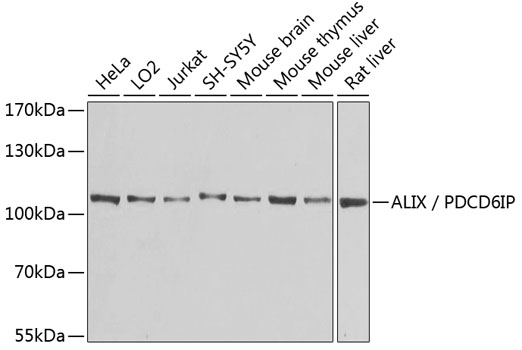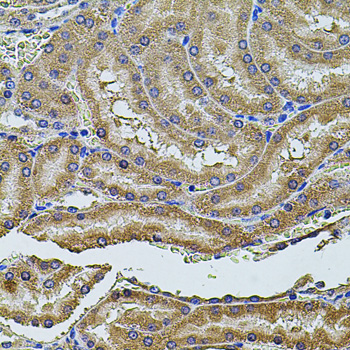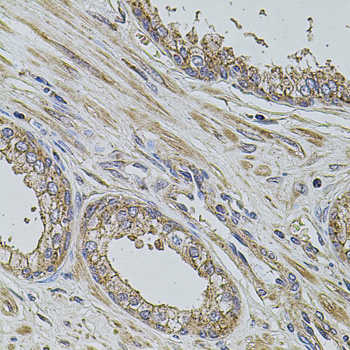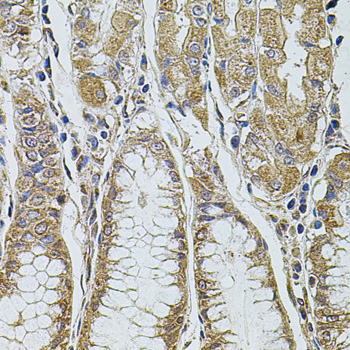-
Product Name
ALIX / PDCD6IP Polyclonal Antibody
- Documents
-
Description
Polyclonal antibody to ALIX / PDCD6IP
-
Tested applications
WB, IHC
-
Species reactivity
Human, Mouse, Rat
-
Alternative names
PDCD6IP antibody; AIP1 antibody; ALIX antibody; DRIP4 antibody; HP95 antibody; programmed cell death 6-interacting protein antibody
-
Isotype
Rabbit IgG
-
Preparation
Antigen: Recombinant fusion protein containing a sequence corresponding to amino acids 1-180 of human ALIX / PDCD6IP (NP_037506.2).
-
Clonality
Polyclonal
-
Formulation
PBS with 0.02% sodium azide, 50% glycerol, pH7.3.
-
Storage instructions
Store at -20℃. Avoid freeze / thaw cycles.
-
Applications
WB 1:200 - 1:2000
IHC 1:50 - 1:200 -
Validations

Western blot - ALIX / PDCD6IP Polyclonal Antibody
Western blot analysis of extracts of various cell lines, using ALIX / PDCD6IP antibody at 1:1000 dilution.Secondary antibody: HRP Goat Anti-Rabbit IgG (H+L) at 1:10000 dilution.Lysates/proteins: 25ug per lane.Blocking buffer: 3% nonfat dry milk in TBST.Detection: ECL Enhanced Kit .Exposure time: 3min.

Immunohistochemistry - ALIX / PDCD6IP Polyclonal Antibody
Immunohistochemistry of paraffin-embedded rat kidney using ALIX / PDCD6IP antibody at dilution of 1:100 (40x lens).

Immunohistochemistry - ALIX / PDCD6IP Polyclonal Antibody
Immunohistochemistry of paraffin-embedded human prostate using ALIX / PDCD6IP antibody at dilution of 1:100 (40x lens).

Immunohistochemistry - ALIX / PDCD6IP Polyclonal Antibody
Immunohistochemistry of paraffin-embedded human stomach using ALIX / PDCD6IP antibody at dilution of 1:100 (40x lens).
-
Background
Multifunctional protein involved in endocytosis, multivesicular body biogenesis, membrane repair, cytokinesis, apoptosis and maintenance of tight junction integrity. Class E VPS protein involved in concentration and sorting of cargo proteins of the multivesicular body (MVB) for incorporation into intralumenal vesicles (ILVs) that are generated by invagination and scission from the limiting membrane of the endosome. Binds to the phospholipid lysobisphosphatidic acid (LBPA) which is abundant in MVBs internal membranes. The MVB pathway requires the sequential function of ESCRT-O, -I,-II and -III complexes. The ESCRT machinery also functions in topologically equivalent membrane fission events, such as the terminal stages of cytokinesis. Adapter for a subset of ESCRT-III proteins, such as CHMP4, to function at distinct membranes. Required for completion of cytokinesis. May play a role in the regulation of both apoptosis and cell proliferation. Regulates exosome biogenesis in concert with SDC1/4 and SDCBP. By interacting with F-actin, PARD3 and TJP1 secures the proper assembly and positioning of actomyosin-tight junction complex at the apical sides of adjacent epithelial cells that defines a spatial membrane domain essential for the maintenance of epithelial cell polarity and barrier (By similarity).; (Microbial infection) Involved in HIV-1 virus budding. Can replace TSG101 it its role of supporting HIV-1 release; this function requires the interaction with CHMP4B. The ESCRT machinery also functions in topologically equivalent membrane fission events, such as enveloped virus budding (HIV-1 and other lentiviruses).
Related Products / Services
Please note: All products are "FOR RESEARCH USE ONLY AND ARE NOT INTENDED FOR DIAGNOSTIC OR THERAPEUTIC USE"
